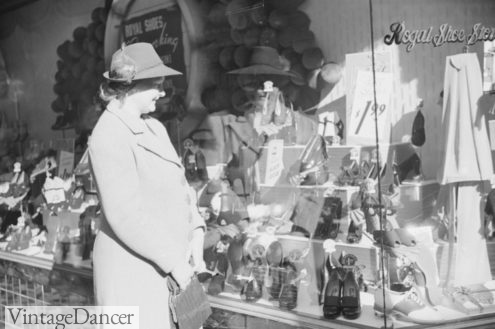
Window shopping for shoes, 1939
What is in your closet? The number of clothing we have today is massive compared to the limited wardrobes from 1910 to 1960s. With smaller incomes, higher quality clothing, less variety of clothing, and more home sewing skills, the pre-fast fashion years were one of careful planning and dedication to wearing clothes out completely. So, what was in a 1920s wardrobe vs. a 1950s wardrobe? How many clothes did men and women need to purchase every year? How did working classes vs city folk shop differently?
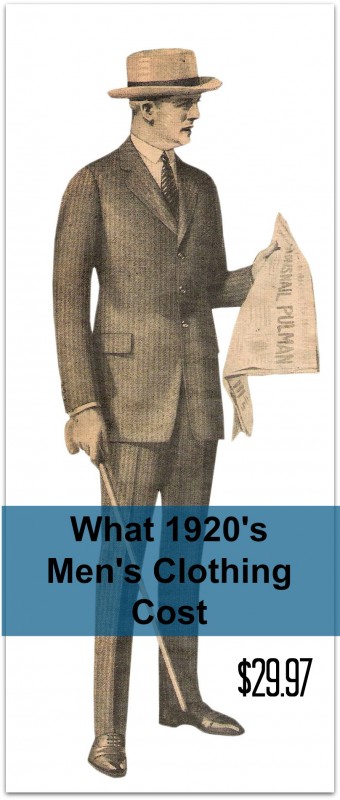
Business suit $29.75 or $413.50 in todays USA currency
These are the types of questions I set out to answer using a few different resources: 1. American government surveys usually tied to a specific region or occupation. They tended to focus on the working classes – farmers, laborers, occasionally city dwellers, and 2. High school girls’ home-economics books. Girls were taught to budget, sew, purchase and repair clothing. They often included lists of clothing the typical student needed.
The difference between classes – working farmers vs. middle class city families – was surprisingly little. Time and time again I read about how more income only meant spending more on a clothing item, not necessarily buying more of them. The exception was young, single women, who spent more on dresses, shoes and hats every year than any other age group. Upper classes also bought more variety of clothing, specialty clothing, and formal wear.
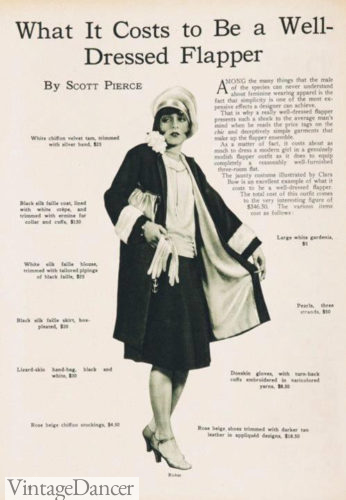
What a Well Dressed Flapper Costs
Men’s clothing usually cost more than women’s, but lasted longer and was purchased less often. Working classes spent more time sewing and repairing clothing at home, however by the mid 1950s, few women of any class sewed clothing. They continued to sew aprons, baby clothes, and gifts but only a handful sewed a personal wardrobe. Even less women knit clothing. Men’s clothing was almost never homemade during any of the decades I looked at.
Clothing was replaced only as needed, not because the fashion trends changed. Most major garments like dresses and suits were purchased every 2 years. Clothing was also repaired, cleaned or shaped (hats), which also took a bit of the clothing budget each year.
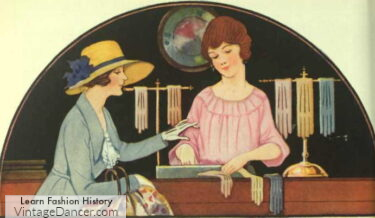
Shopping for glove sin 1922
High-use items such as hosiery were purchased frequently throughout the year. Underwear, however, was not replaced as often as I expected. Men and women only had a few pairs in their drawer at a time, possibly re-wearing them several times before going to the wash. They were made significantly better and lasted longer than our underwear today, but still, I’m a little grossed-out.
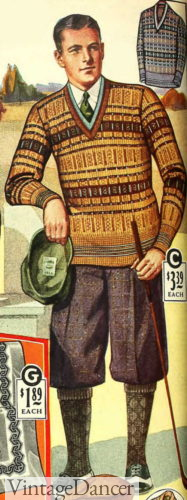
1927 Golf Outfit
Of the lists below, there are some items missing. Specialty sportswear was purchased by the classes that could afford it, but never made it to these lists. Certain styles of clothing such as a specific jacket or type of negligee might have been lumped into a general category.
Women’s lingerie, too, had so much variety and personal preference that the lists are generalized and not very specific. Clothing for special occasions such as travel, weddings, summer vacations, and school uniforms are also missing.
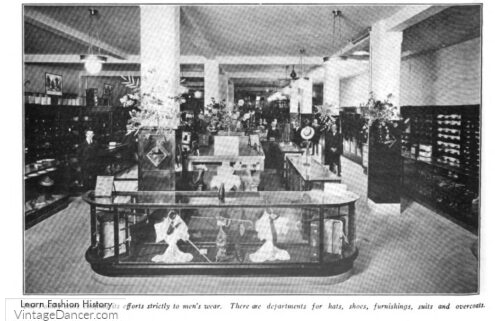
1924, men’s clothing store
The final things to note about these lists is that most are compilations of clothing that were purchased each year (or every few years). A person certainly had more than these items in their wardrobe at any given time. Everything was worn until it was no longer usable.
For example, a man’s new hat was saved for special occasions and his old hat became his working hat. A woman’s old street dress became a house dress before it was eventually made into an apron or children’s clothing. Hats were re-trimmed. Shoes were re-soled and heels replaced several times a year. Many smaller items were never purchased because they were given as gifts at Christmas.
On to the wardrobe lists!

1920s Capsule Wardrobe Plans
A 15-20% budget for clothing was average (a small increase since 10 years earlier). Young women with no families to dress spent the most on clothing. Middle aged women with families spent less on themselves but more for the entire family. Older women with grown families spent the least on clothes.
Young women spent more on hats, dresses and shoes, but about the same on lingerie and accessories as older women. The annual budget for young women was $22 for dresses, $16 for shoes, $8 for lingerie, and $3 for hats.
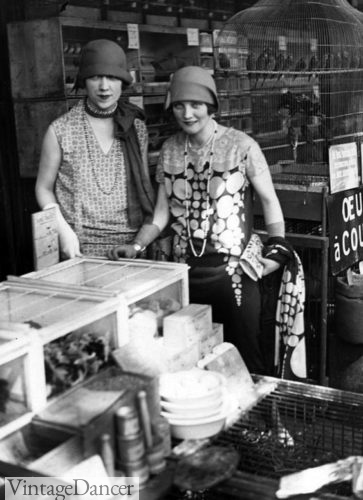
1925 young flapper dress up in afternoon dresses with hats and jewelry.
A 1927 study of women farmers said: 90% of women purchased new shoes at least once a year. Most also bought work dresses, hosiery, aprons and lingerie. A new coat was purchased every 3 years. Silk dresses were a rare purchase – about 1 every 5 years, if that.
Most dresses were homemade, with less than 40% being purchased. Aprons, slips, corsets, and nightgowns were often homemade as well. Knitted goods were rarely ever homemade (Did not enough women know how or were they just too time consuming to make?).
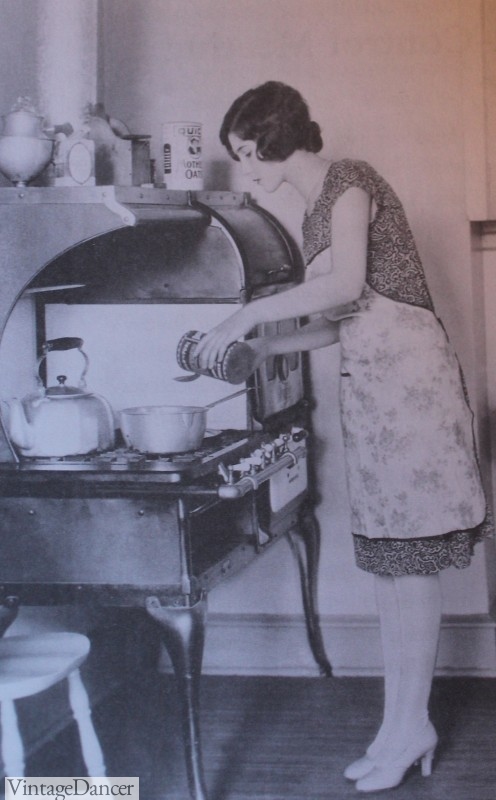
1925 ad for a stove shows a woman with a pin on cooking apron
1927 Farmer’s Wife:
- Shoes – 2 pairs shoes, 1 pair rubber boots, 1 pair snow boots.
- Dresses – 3 work dresses, 1-2 wool dresses, 1-2 cotton afternoon dresses, 1 silk dress.
- Stockings – 4 silk, 6 cotton, 2-4 wool.
- Aprons – 3 or 4.
- Summer lingerie – 2 or 3.
- Hats – 1.
- Lingerie – 2-3 sets summer lingerie, 1 corset.
- Underwear – 2 slips, 2-3 bloomers, 2 sets winter underwear.
- Nightgowns – 1 or 2.
- Gloves – 1 or 2 pairs.
- Coats – 1 coat, 1 kimono/robe, 1 raincoat purchased every 4-5 years.
- Purses – 1.
- Sweaters – 1.
- Neck wear – as needed.
- Skirts and waists (blouses) – less than 1 **
** The lower spending on skirts and blouses had to do with them being out of fashion in 1927. The early 1920s would have shown a higher number of purchases of separates.
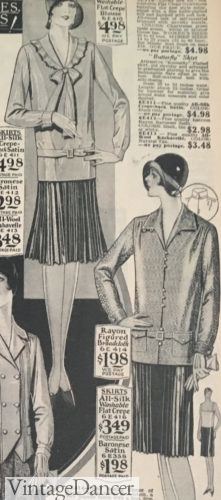
1929 blouse and skirt separates return
1925 Man, Working Laborer:
- Suits with extra trousers – 1.
- Work Trousers – 2.
- Overalls – 3.
- Work vests – 2.
- Sweaters – 1.
- Coats – 1 Overcoat or Mackinaw jacket.
- Hat – 1 hat, 1 cap.
- Shoes – 3 work boots, 1 pair rubber overshoes, 1 pair dress shoes, plus repairs.
- Gloves – 1 pair canvas work, 1 pair woolen winter.
- Underwear – 3 union suits for winter, 2 union suits for summer.
- Socks – 3 wool socks, 8 cotton socks.
- Shirts – 2 woolen, 3 cotton, 2 dress shirts.
- Nightshirts – 2 winter pajama, 2 summer nightshirts.
- Ties – as needed.
- Suspenders – 2.
- Handkerchiefs – 12 cotton.
Source. Includes additional records for a wife, a shop girl, and children.
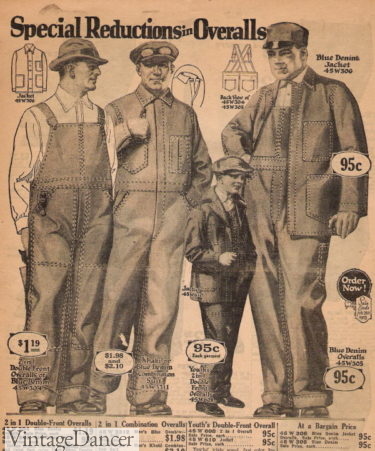
1923 overalls and coveralls
1920s Wealthy man
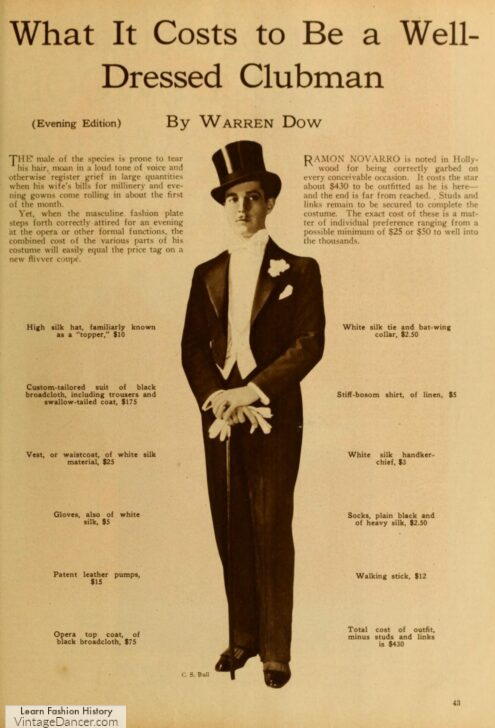
1926 how to be a well dress club man $430
1930s Capsule Wardrobes
The drop in economy sent many families back into frugal living in the 1930s, however clothing manufactures, eager to keep up spending, managed to reduce the quality of clothing, increase the prettiness, and lower the cost significantly. The plan worked. Women continued to purchase clothing as often as before the stock-market crash of 1929, but spent less money overall.
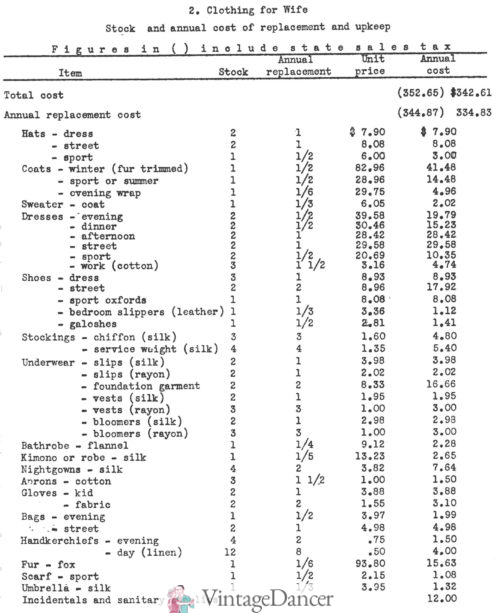
1935 wealthy woman’s wardrobe
1930 Teen Girl:
- Coats – 3-6 for winter, spring, rain.
- Hats – 2 winter, 2 spring.
- Gloves – 2.
- Stockings – 8.
- Underwear – 6 pairs.
- Slips – 6.
- Dresses – 8.
- Blouses – 2.
- Skirts – 1.
- Sweaters – 2.
- Gym – 3 pairs gym clothes, 1 pair gym shoes.
- Shoes – 2 pairs, 1 pair rain boots.
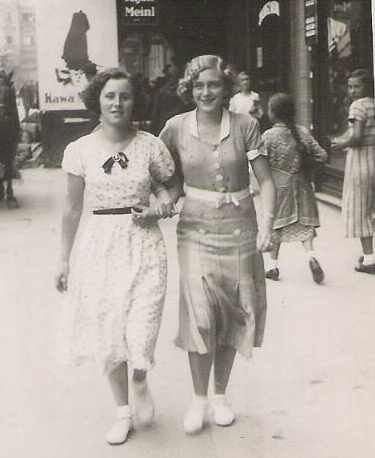
1930s teen girls
1937 Female College Student:
- Dresses – 4 street dresses, 1 formal dress.
- Suit – 1.
- Skirt – 1.
- Blouses – 2.
- Hats – 1-2.
- Shoes – 2 pairs daywear, 1 pair dancing (shoes were 30% of budget).
- Coats – 1.
- Sweaters – 2.
- Swimming Suits – 1 (15% of budget).
- Hosiery – 6 (26% of budget).
- Gloves – 1-2.
- Pajamas – 2.
- Lingerie – 3 step ins, 2 panties (10% of budget).
- Slips – 1.
- Bag – 1.
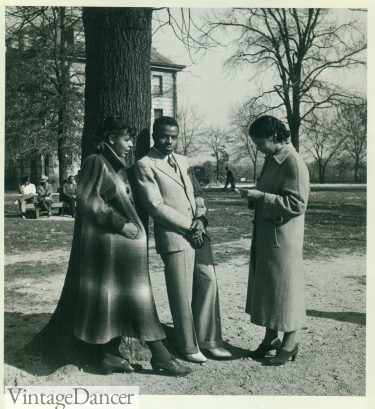
1936 Virginia Union College Students
1937 Male College Student in the City – minimum needed:
- Suits – 3 suits replaced every 2 years, 1 tuxedo.
- Trousers – 1-2 extra trousers (1 white flannel for summer.
- Coat – 1 winter coat, 1 raincoat, both replaced every 3-4 years.
- Sweaters – 2.
- Handkerchiefs – 11.
- Gloves – 1 winter.
- Shoes – 2 pairs, 1 pair slippers.
- Socks – 6.
- Hats – 1 straw, 1 felt, 1 winter cap, replaced yearly or every other season
- Neckties – 6.
- Shirts – 4 casual shirts, 2 dress shirts.
- Pajamas – 3.
- Underwear set – 3.
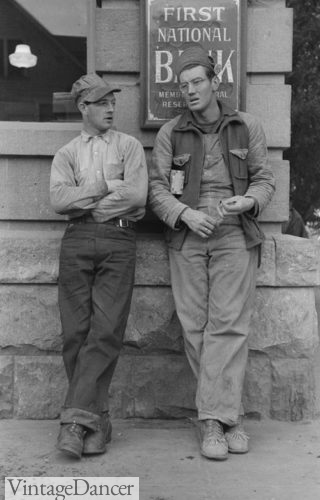
Farmers wearing denim pants and overalls
1937 Working Man, Street-Car Operator:
- Hats – 2 purchased every 4 years, 1 uniform cap purchased every 3 years.
- Coats – 1 overcoat purchased every 7 years, 1 raincoat purchased every 6 years.
- Sweaters – 1 purchased every 3 years.
- Uniforms – 1 purchased every 2 years.
- Suits – 1 purchased every 3 years.
- Pants (separates) – 1 purchased every 5 years.
- Overalls – 1 purchased every 4 years.
- Shirts – 6 purchased every 3 years.
- Underwear – 3 purchased every 2 years.
- Nightclothes – 2, one new pair purchased yearly.
- Socks – 6, purchased yearly.
- Sock Garters – 1 per year, purchased every 2-3 years.
- Shoes – 2 pairs with 1 pair purchased yearly, 1 pair rubber boots purchased every 3 years.
- Gloves – 1 purchased yearly.
- Shirt Collars – 7, 3-4 purchased yearly.
- Ties – 6, two gifted yearly.
- Handkerchiefs – 12, four new ones purchased yearly.
- Belts – 1.
- Bag– 1, purchased as needed.
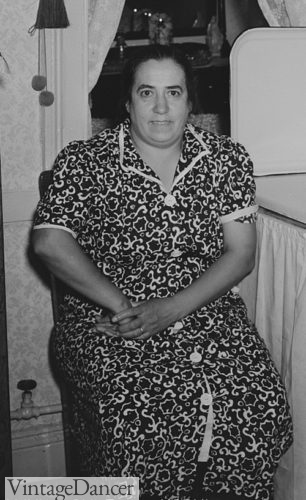
1936 Mrs. Montefiori, New York
1937 Street Car Man’s Wife:
- Hats – 2, one purchased yearly.
- Coats – 1 purchased every 2 years.
- Sweaters – 1 purchased every 3 years.
- Dresses – 4, two handmade every 1-2 years.
- Other Dresses/Suits/Skirt+Blouse Separates – 3, one purchased every 1-2 years.
- Aprons – 3, one handmade 1-2 years.
- Corsets– 1 purchased or made every 3 years.
- Underwear – 3, two purchased yearly.
- Nightgowns/pajamas – 3, one purchased yearly.
- Silk Stockings – 6-9 purchased yearly.
- Shoes – 2 pairs with 1 pair purchased yearly, 1 pair galoshes (rainboots) every 10 years.
- Gloves – 2 purchased every 4 years.
- Handkerchiefs – 12 received as gifts.
- Purse – 1 purchased every 2 years.
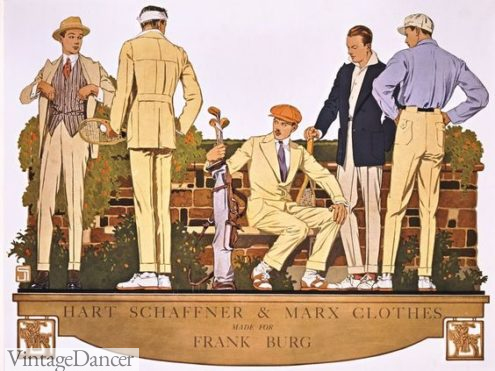
1930s Summer Clothing
1935 Executive Man (wealthy):
- Hats – 2 felt, 1 straw (purchased yearly).
- Overcoat – 1 purchased every 3 years.
- Sweater – 1 pullover purchased every 3 years.
- Suits – 1 tuxedo purchased every 10 years, 3 business suits (1 new suit a year), $12 budget for cleaning.
- Trousers – 1 extra pair purchased every 3 years.
- Shoes – 1 pair dress purchased every 2 years, 2 business replaced as needed, 1 golf replaced as needed, 1 leather slippers replaced as needed, budget for 50 shoe shines a year.
- Shirts – 3 dress, 3 un-collared shirts, 8 collared shirts.
- Collars – 3 stiff, 6 soft, 6 total purchased yearly.
- Socks – 3 black silk socks, 8 cotton socks, 3 wool socks, 2 sock garters (purchased 10 socks every year).
- Underwear – 6 shirt and shorts sets (purchased 4 every year).
- Bathrobes – 1 flannel purchased every 6 years.
- Pajamas – 3 cotton, 2 purchased every year.
- Ties – 1 black bow tie, 9 neckties (purchased 6 every year, 1 bow tie every 2 years).
- Handkerchiefs – 14 linen, purchased 9 every year.
- Gloves – 2, 1 purchased every year.
- Belts – 1 purchased every 2 years.
- Suspenders – 2, purchased 1 every 2 years.
- Mufflers – 1 dressy silk, 1 optional winter scarf.
- Wallets – 1 purchased every 3 years.
Source – includes additional budgets for lower classes.
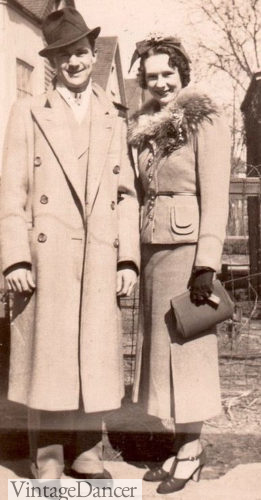
1937 short jacket with fur collar
1935 Executive Man’s Wife (wealthy)
- Dresses – 2 evening, 2 dinner, 2 afternoon, 2 street or suit , 2 sports, 3 cotton housedresses, 6 total purchased every year.
- Blouses – purchased 3 per year.
- Skirts – purchased 1-2 per year.
- Underwear – 2-3 sets of tops and panties/bloomers.
- Corset/girdles – 2.
- Slips – 2 silk, 2 rayon.
- Pajamas – 4 silk nightgowns or pajamas.
- Robes – 1 flannel, 1 silk.
- Stockings – 3 dressy silk, 4 daywear silk (purchased 7 total a year).
- Shoes – 3 dress, 2 street, 1 sport Oxfords, 1 leather slippers, 1 rubber boots (purchased 4 total a year).
- Coats – 1 winter with fur trim, 1 summer or sport coat, 1 evening wrap, 1 fox fur stole.
- Gloves – 2 cotton, 2 leather.
- Purses – 2 day, 1 evening.
- Hats – 2 dress, 2 street, 1 sport.
- Aprons – 3 cotton.
- Handkerchiefs – 12 linen, 4 evening.
Source – includes additional budgets for lower classes.
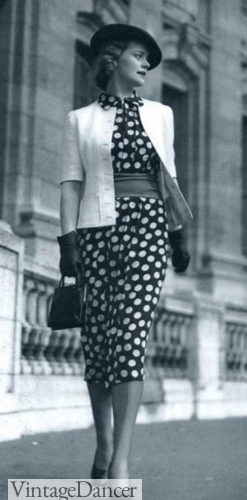
Dress with jacket
1939 Single, Professional Woman:
- Dresses – 4-7 in various styles.
- Suits – 1 (only 1 out of three women purchased suits).
- Blouses – 3 purchased yearly.
- Skirts – 1-2 purchased yearly.
- Underwear – 3 sets.
- Lingerie – 1-2 corsets/girdles, 1 brassiere.
- Slips – 2.
- Pajamas – 1-2 purchased yearly.
- Robes – 1 purchased every 2 years.
- Stockings – 17 purchased yearly.
- Shoes – 2-6 pairs (including daywear, dress, boots, slippers).
- Coat – 1 coat or light wrap purchased yearly.
- Gloves – 2-4 purchased yearly.
- Purse – 2 purchased yearly.
- Hats – 2-4 purchased yearly
- Sport Clothes – only as necessary. Often reused existing clothing instead of buying special sportswear like riding clothes, tennis clothing, golf apparel.
From here on out, clothing purchases only grew more and more. Wardrobes expanded at record rates. Could you survive on what a 1918 person wore? How about the 1940s or 1950s? What surprised you the most about the clothing people bought?
More Capsule Wardrobe Plans
- 1910s Capsule Wardrobe & What Clothing Cost
- 1940s Capsule Wardrobe & What Clothing Cost
- 1950s Capsule Wardrobes- What Clothing Women and Men Owned
Debbie Sessions has been teaching fashion history and helping people dress for vintage themed events since 2009. She has turned a hobby into VintageDancer.com with hundreds of well researched articles and hand picked links to vintage inspired clothing online. She aims to make dressing accurately (or not) an affordable option for all. Oh, and she dances too.